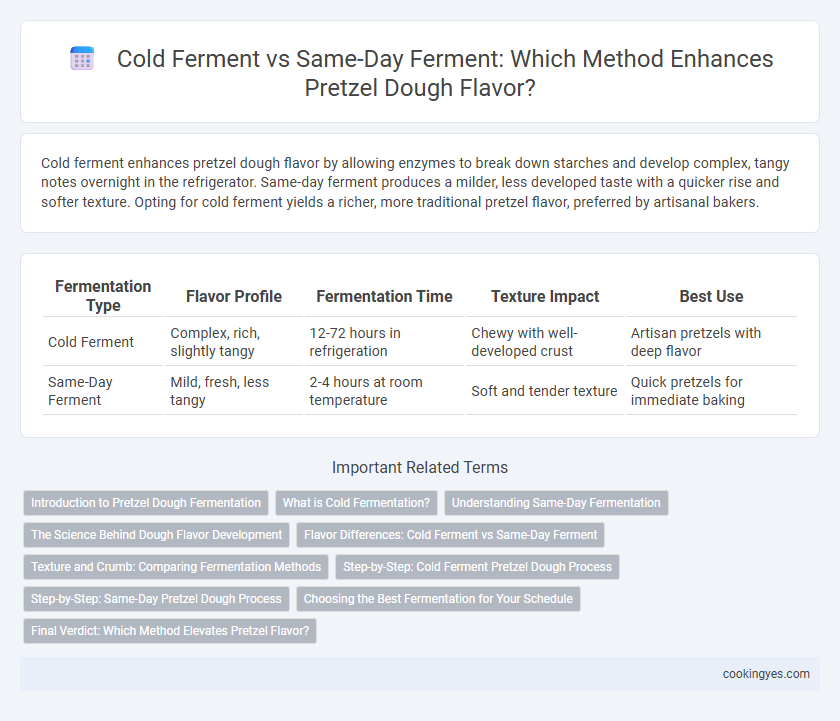Cold ferment enhances pretzel dough flavor by allowing enzymes to break down starches and develop complex, tangy notes overnight in the refrigerator. Same-day ferment produces a milder, less developed taste with a quicker rise and softer texture. Opting for cold ferment yields a richer, more traditional pretzel flavor, preferred by artisanal bakers.
Table of Comparison
| Fermentation Type | Flavor Profile | Fermentation Time | Texture Impact | Best Use |
|---|---|---|---|---|
| Cold Ferment | Complex, rich, slightly tangy | 12-72 hours in refrigeration | Chewy with well-developed crust | Artisan pretzels with deep flavor |
| Same-Day Ferment | Mild, fresh, less tangy | 2-4 hours at room temperature | Soft and tender texture | Quick pretzels for immediate baking |
Introduction to Pretzel Dough Fermentation
Cold ferment enhances pretzel dough flavor by allowing yeast to develop slowly over 12 to 72 hours, producing more complex and tangy notes. Same-day ferment provides a quicker rise, typically 2 to 4 hours, resulting in a milder taste with less depth. Temperature control and fermentation duration significantly impact gluten structure, dough texture, and ultimately the characteristic pretzel crust and chew.
What is Cold Fermentation?
Cold fermentation is a dough fermentation process where the dough is refrigerated at temperatures between 34degF and 40degF (1degC to 4degC) for an extended period, usually 12 to 72 hours. This slow fermentation allows yeast to produce more complex flavors and enhances the dough's texture by breaking down starches and proteins gradually. Compared to same-day fermentation, cold fermentation results in a richer, tangier flavor profile ideal for artisanal pretzels.
Understanding Same-Day Fermentation
Same-day fermentation accelerates dough rising by allowing yeast to activate quickly, producing a mild, straightforward flavor profile ideal for fresh, soft pretzels. This method results in less complex flavor development compared to cold fermentation, as shorter fermentation limits organic acid and ester formation. Bakers choose same-day fermentation to meet fast production schedules while maintaining a consistent, slightly tangy taste typical in traditional pretzels.
The Science Behind Dough Flavor Development
Cold ferment enhances dough flavor by allowing slow enzymatic reactions and yeast activity over 12 to 72 hours, resulting in complex organic acids and sugars that deepen pretzel taste. Same-day ferment speeds fermentation within 2 to 4 hours, producing less developed flavor due to limited time for biochemical reactions. The extended cold fermentation promotes higher isoamyl acetate and lactic acid formation, enriching aroma and tang in pretzel dough.
Flavor Differences: Cold Ferment vs Same-Day Ferment
Cold fermenting pretzel dough enhances flavor complexity by allowing enzymatic reactions to develop deeper, tangier notes over 24-72 hours, resulting in a richer and more nuanced taste. Same-day fermenting produces a milder, fresher flavor profile with a softer texture due to the shorter fermentation time and less acid development. The prolonged fermentation of cold dough encourages enhanced Maillard reaction during baking, creating a more robust crust and intensified aroma compared to same-day fermentation.
Texture and Crumb: Comparing Fermentation Methods
Cold ferment enhances dough flavor by allowing slower yeast activity, resulting in a chewier texture and a more open, airy crumb with irregular holes in pretzels. Same-day ferment produces a softer texture and denser crumb due to faster yeast fermentation and less development time. The choice between cold and same-day fermentation directly impacts the pretzel's chewiness and crumb structure, influencing overall mouthfeel and flavor complexity.
Step-by-Step: Cold Ferment Pretzel Dough Process
Cold ferment pretzel dough enhances flavor by allowing yeast to develop slowly over 12 to 48 hours in refrigeration, resulting in a deeper, tangier taste compared to same-day ferment. Begin by mixing flour, water, yeast, salt, and malt syrup, then refrigerate the dough covered for at least 24 hours to encourage enzymatic activity and complex flavor compounds. Before shaping, bring the dough to room temperature to relax gluten, then proceed with boiling in baking soda solution and baking for characteristic pretzel crust and taste.
Step-by-Step: Same-Day Pretzel Dough Process
Same-day pretzel dough fermentation completes the mixing, resting, shaping, and boiling within a few hours, delivering a mildly tangy and fresh flavor due to limited yeast activity. Cold fermenting extends fermentation to 12-48 hours in refrigeration, enhancing complex flavor development with increased lactic acid and yeast byproducts. Choosing same-day fermentation ensures quicker production with softer texture and lighter taste, while cold ferment provides richer, deeper pretzel flavor and improved dough structure.
Choosing the Best Fermentation for Your Schedule
Cold ferment enhances pretzel dough flavor by allowing slow yeast activity and complex enzymatic reactions over 12 to 72 hours, resulting in a deeper, richer taste and chewier texture. Same-day ferment offers a quicker turnaround within 2 to 4 hours, producing a milder flavor and softer crust, ideal for busy schedules or last-minute baking. Selecting the best fermentation method depends on balancing desired flavor depth with available preparation time.
Final Verdict: Which Method Elevates Pretzel Flavor?
Cold ferment enhances pretzel flavor by allowing enzymes more time to break down starches into sugars, resulting in a richer, complex taste and a chewier texture. Same-day ferment produces a fresher, slightly tangier dough with quicker gas development but lacks the depth of flavor found in cold-fermented dough. For elevating pretzel flavor, cold ferment is the preferred method due to its superior flavor complexity and improved dough structure.
Cold ferment vs same-day ferment for dough flavor Infographic

 cookingyes.com
cookingyes.com